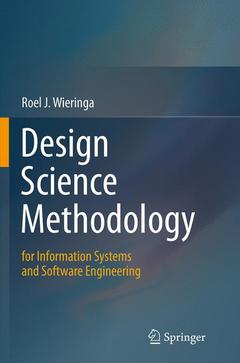Description
Design Science Methodology for Information Systems and Software Engineering, 2014
Language: English
Subjects for Design Science Methodology for Information Systems and...:
Publication date: 08-2016
Support: Print on demand
Publication date: 12-2014
332 p. · 15.5x23.5 cm · Hardback
Description
/li>Contents
/li>Biography
/li>Comment
/li>
This book provides guidelines for practicing design science in the fields of information systems and software engineering research. A design process usually iterates over two activities: first designing an artifact that improves something for stakeholders and subsequently empirically investigating the performance of that artifact in its context. This ?validation in context? is a key feature of the book - since an artifact is designed for a context, it should also be validated in this context.
The book is divided into five parts. Part I discusses the fundamental nature of design science and its artifacts, as well as related design research questions and goals. Part II deals with the design cycle, i.e. the creation, design and validation of artifacts based on requirements and stakeholder goals. To elaborate this further, Part III presents the role of conceptual frameworks and theories in design science. Part IV continues with the empirical cycle to investigate artifacts in context, and presents the different elements of research problem analysis, research setup and data analysis. Finally, Part V deals with the practical application of the empirical cycle by presenting in detail various research methods, including observational case studies, case-based and sample-based experiments and technical action research. These main sections are complemented by two generic checklists, one for the design cycle and one for the empirical cycle.
The book is written for students as well as academic and industrial researchers in software engineering or information systems. It provides guidelines on how to effectively structure research goals, how to analyze research problems concerning design goals and knowledge questions, how to validate artifact designs and how to empirically investigate artifacts in context ? and finally how to present the results of the design cycle as a whole.
Describes research methodologies for design science research in information systems and software engineering
Provides guidelines for how to structure your research goals and analyse your research problem into design goals and knowledge questions
Gives guidelines for investigating design problems and for validating new technology
Includes supplementary material: sn.pub/extras

